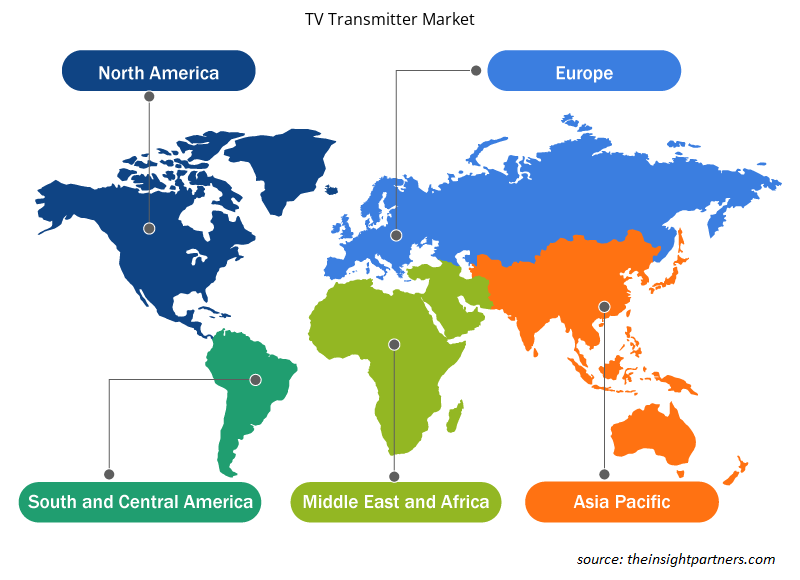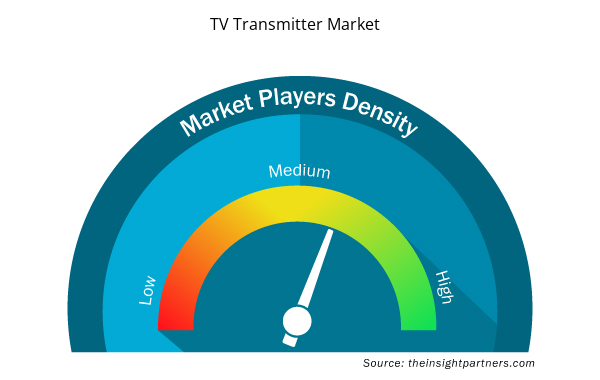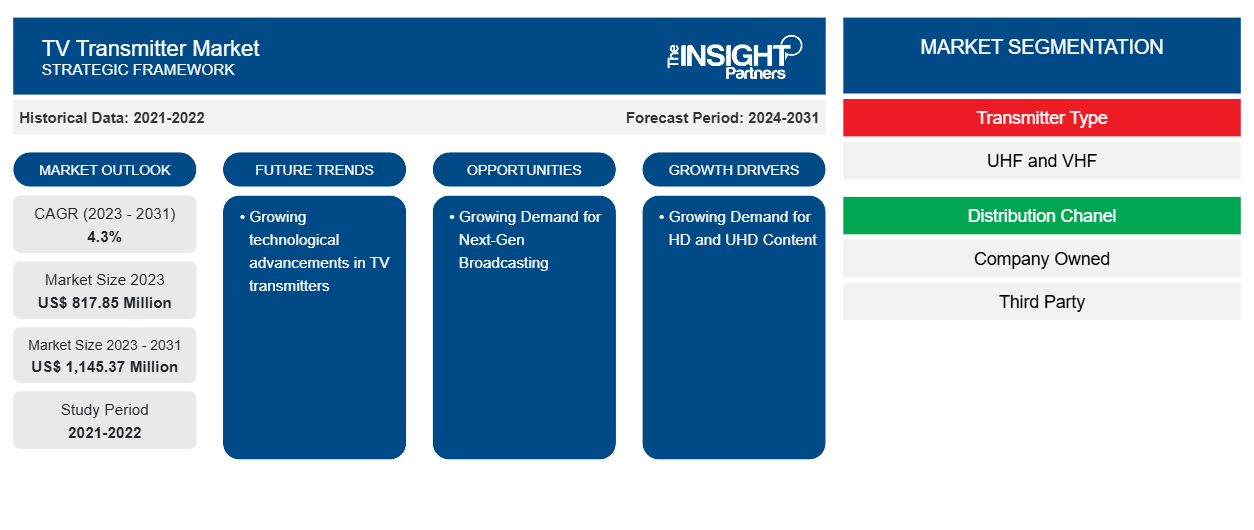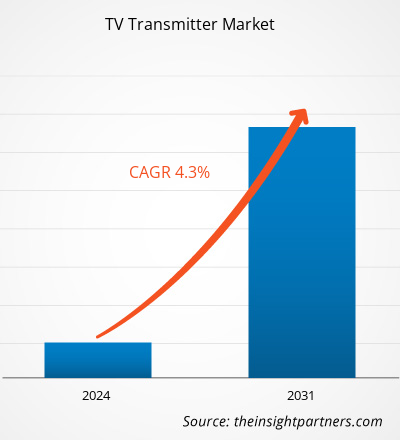من المتوقع أن يصل حجم سوق أجهزة إرسال التلفزيون إلى 1,145.37 مليون دولار أمريكي بحلول عام 2031 من 817.85 مليون دولار أمريكي في عام 2023. ومن المتوقع أن يسجل السوق معدل نمو سنوي مركب بنسبة 4.3٪ في الفترة 2023-2031. ومن المرجح أن يظل الطلب المتزايد على المحتوى عالي الدقة اتجاهًا رئيسيًا في سوق أجهزة إرسال التلفزيون.
تحليل سوق أجهزة الإرسال التلفزيونية
الطلب المتزايد على محتوى HD وUHD في جميع أنحاء العالم هو أحد العوامل الرئيسية التي تغذي نمو سوق أجهزة إرسال التلفزيون. بالإضافة إلى ذلك، تعمل الابتكارات المستمرة في قطاع الاتصالات والبث على دفع نمو سوق أجهزة إرسال التلفزيون. علاوة على ذلك، من المتوقع أن يعزز الطلب المتزايد على البث من الجيل التالي نمو السوق في الفترة المتوقعة. علاوة على ذلك، فإن التقدم التكنولوجي المتزايد في أجهزة إرسال التلفزيون يخلق فرصة لنمو سوق أجهزة إرسال التلفزيون في السنوات القادمة.
نظرة عامة على سوق أجهزة إرسال التلفزيون
جهاز إرسال التلفزيون هو جهاز كهربائي يصدر موجات راديو تحمل إشارة الفيديو التي تعرض صورة ديناميكية وإشارة الصوت المتزامنة معها. سيتم استقبالها بواسطة جهاز استقبال تلفزيوني، والذي سيعرض الصورة على الشاشة ويشغل الصوت المطابق. يقتصر تردد تشغيله على نطاقي التردد VHF وUHF ويتراوح خرج الطاقة من 5 وات إلى 10 كيلو وات. يتم استخدامه بشكل شائع في مجال البث التلفزيوني ، مثل محطات التلفزيون.
قم بتخصيص هذا التقرير ليناسب متطلباتك
ستحصل على تخصيص لأي تقرير - مجانًا - بما في ذلك أجزاء من هذا التقرير، أو تحليل على مستوى الدولة، وحزمة بيانات Excel، بالإضافة إلى الاستفادة من العروض والخصومات الرائعة للشركات الناشئة والجامعات
- احصل على أهم اتجاهات السوق الرئيسية لهذا التقرير.ستتضمن هذه العينة المجانية تحليلاً للبيانات، بدءًا من اتجاهات السوق وحتى التقديرات والتوقعات.
محركات وفرص سوق أجهزة إرسال التلفزيون
الطلب المتزايد على المحتوى عالي الدقة والوضوح الفائق
يتزايد الطلب على المحتوى عالي الدقة (HD) وفائق الدقة (UHD) بين المستهلكين في جميع أنحاء العالم، وخاصة لأنه يوفر صوتًا وفيديو عالي الجودة. علاوة على ذلك، يتزايد استخدام منصات OTT في جميع أنحاء العالم جنبًا إلى جنب مع إصدارات المحتوى عالي الجودة. وبالتالي، فإن الطلب المتزايد على المحتوى عالي الجودة يغذي نمو سوق أجهزة الإرسال التلفزيونية.
النموالطلب على البث من الجيل التالي
يتضمن البث من الجيل التالي اعتماد معايير البث الرقمي، مع تبني مناطق مختلفة في جميع أنحاء العالم لمعايير محددة مثل ATSC 3.0 في الولايات المتحدة، وDVB-T2 في أوروبا، وISDB-Tb في أجزاء معينة من آسيا وأمريكا الجنوبية. تشمل الفوائد المترتبة على هذه المعايير تحسين جودة الصوت والفيديو، والاستخدام الأكثر فعالية للطيف المتاح، وإضافة ميزات تفاعلية جديدة. يجعل الانتقال إلى معايير البث الرقمي من السهل بث البرامج عالية الدقة (HD) وفائقة الدقة (UHD)، مما يمنح المشاهدين تجربة بصرية وصوتية أفضل بكثير ويزيد من استمتاعهم بالتلفزيون. وبالتالي، من المتوقع أن يخلق الطلب المتزايد على البث من الجيل التالي فرصة لنمو سوق أجهزة الإرسال التلفزيونية.
تقرير تحليل تجزئة سوق أجهزة إرسال التلفزيون
إن القطاعات الرئيسية التي ساهمت في اشتقاق تحليل سوق أجهزة إرسال التلفزيون هي نوع جهاز الإرسال وقناة التوزيع والتطبيق.
- بناءً على نوع جهاز الإرسال، ينقسم سوق أجهزة إرسال التلفزيون إلى UHF وVHF. احتل قطاع UHF حصة سوقية أكبر في عام 2023. ينقسم قطاع UHF إلى منخفض ومتوسط وعالي. وبالمثل، ينقسم قطاع VHF إلى منخفض ومتوسط.
- بحسب قناة التوزيع، تم تقسيم السوق إلى شركات مملوكة وأطراف ثالثة. احتلت شريحة الشركات المملوكة الحصة الأكبر من السوق في عام 2023.
- من حيث التطبيق، تم تقسيم السوق إلى محطات تلفزيونية صغيرة ومحطات تلفزيونية كبيرة. احتل قطاع محطات التلفزيون الكبيرة الحصة الأكبر من السوق في عام 2023.
تحليل حصة سوق أجهزة إرسال التلفزيون حسب المنطقة الجغرافية
ينقسم النطاق الجغرافي لتقرير سوق أجهزة إرسال التلفزيون بشكل أساسي إلى خمس مناطق: أمريكا الشمالية، ومنطقة آسيا والمحيط الهادئ، وأوروبا، والشرق الأوسط وأفريقيا، وأمريكا الجنوبية/أمريكا الجنوبية والوسطى.
من حيث الإيرادات، استحوذت منطقة آسيا والمحيط الهادئ على أكبر حصة في سوق أجهزة الإرسال التلفزيونية. وتنقسم السوق في هذه المنطقة إلى أستراليا والصين والهند وكوريا الجنوبية واليابان وبقية منطقة آسيا والمحيط الهادئ. ويعمل اللاعبون في السوق في المنطقة باستمرار على التقدم التكنولوجي في قطاع البث، وهو العامل الرئيسي الذي يغذي نمو سوق أجهزة الإرسال التلفزيونية في منطقة آسيا والمحيط الهادئ. وعلاوة على ذلك، تشهد المنطقة نموًا هائلاً في صناعة الإعلام والترفيه، مما يغذي نمو سوق أجهزة الإرسال التلفزيونية.
رؤى إقليمية حول سوق أجهزة إرسال التلفزيون
لقد قام المحللون في Insight Partners بشرح الاتجاهات والعوامل الإقليمية المؤثرة على سوق أجهزة إرسال التلفزيون طوال فترة التوقعات بشكل شامل. يناقش هذا القسم أيضًا قطاعات سوق أجهزة إرسال التلفزيون والجغرافيا في جميع أنحاء أمريكا الشمالية وأوروبا ومنطقة آسيا والمحيط الهادئ والشرق الأوسط وأفريقيا وأمريكا الجنوبية والوسطى.

- احصل على البيانات الإقليمية المحددة لسوق أجهزة إرسال التلفزيون
نطاق تقرير سوق أجهزة إرسال التلفزيون
| سمة التقرير | تفاصيل |
|---|---|
| حجم السوق في عام 2023 | 817.85 مليون دولار أمريكي |
| حجم السوق بحلول عام 2031 | 1,145.37 مليون دولار أمريكي |
| معدل النمو السنوي المركب العالمي (2023 - 2031) | 4.3% |
| البيانات التاريخية | 2021-2022 |
| فترة التنبؤ | 2024-2031 |
| القطاعات المغطاة | حسب نوع المرسل
|
| المناطق والدول المغطاة | أمريكا الشمالية
|
| قادة السوق وملفات تعريف الشركات الرئيسية |
|
كثافة اللاعبين في سوق أجهزة إرسال التلفزيون: فهم تأثيرها على ديناميكيات الأعمال
يشهد سوق أجهزة إرسال التلفزيون نموًا سريعًا، مدفوعًا بالطلب المتزايد من المستخدم النهائي بسبب عوامل مثل تفضيلات المستهلك المتطورة والتقدم التكنولوجي والوعي المتزايد بفوائد المنتج. ومع ارتفاع الطلب، تعمل الشركات على توسيع عروضها والابتكار لتلبية احتياجات المستهلكين والاستفادة من الاتجاهات الناشئة، مما يؤدي إلى زيادة نمو السوق.
تشير كثافة اللاعبين في السوق إلى توزيع الشركات أو المؤسسات العاملة في سوق أو صناعة معينة. وهي تشير إلى عدد المنافسين (اللاعبين في السوق) الموجودين في مساحة سوق معينة نسبة إلى حجمها أو قيمتها السوقية الإجمالية.
الشركات الرئيسية العاملة في سوق أجهزة إرسال التلفزيون هي:
- رودي وشوارتز
- شركة NEC
- مجموعة هيتاشي كوكوساي الكهربائية
- بيتسوا
- إيجاتيل
- بوابات جوية
إخلاء المسؤولية : الشركات المذكورة أعلاه ليست مرتبة بأي ترتيب معين.

- احصل على نظرة عامة على أهم اللاعبين الرئيسيين في سوق أجهزة إرسال التلفزيون
أخبار سوق أجهزة الإرسال التلفزيونية والتطورات الأخيرة
يتم تقييم سوق أجهزة إرسال التلفزيون من خلال جمع البيانات النوعية والكمية بعد البحث الأولي والثانوي، والذي يتضمن منشورات الشركات المهمة وبيانات الجمعيات وقواعد البيانات. فيما يلي قائمة بالتطورات في سوق اضطرابات الكلام واللغة والاستراتيجيات:
- أعلنت شركة ENENSYS Technologies، وهي شركة رائدة في تقديم حلول توصيل الوسائط، وشركة ELECTROLINK، وهي شركة إيطالية لتصنيع أجهزة إرسال التلفزيون، عن نجاحها في تسليم جميع أنظمة إرسال DVB-T/T2 العاملة في مناطق أبروتسو ولاتسيو وليغوريا إلى Rai Way، والمتعلقة بمشروع إعادة الزراعة في إيطاليا، والذي تم تكليفه من خلال مناقصة عامة. وقد أقامت ENENSYS وELECTROLINK شراكة خاصة لهذا المشروع، حيث تقدم كل شركة أفضل المكونات والخدمات الهندسية لتقديم نظام إرسال DVB-T/T2 الأكثر كفاءة وموثوقية وحداثة إلى Rai Way. (المصدر: ENENSYS Technologies، بيان صحفي، 2023)
- افتتحت قناة Hope Channel Central Philippines الاستوديو الجديد وموقع البث في مقر مؤتمر اتحاد الفلبين المركزي (CPUC) في مدينة سيبو بالفلبين. (المصدر: الأدفنتست، بيان صحفي، 2023)
تقرير سوق أجهزة إرسال التلفزيون والتغطية والنتائج المتوقعة
يوفر تقرير "حجم سوق أجهزة إرسال التلفزيون والتوقعات (2021-2031)" تحليلاً مفصلاً للسوق يغطي المجالات التالية:
- حجم السوق والتوقعات على المستويات العالمية والإقليمية والوطنية لجميع قطاعات السوق الرئيسية التي يغطيها النطاق
- ديناميكيات السوق مثل المحركات والقيود والفرص الرئيسية
- الاتجاهات المستقبلية الرئيسية
- تحليل مفصل لقوى PEST/Porter الخمس وSWOT
- تحليل السوق العالمي والإقليمي الذي يغطي اتجاهات السوق الرئيسية واللاعبين الرئيسيين واللوائح والتطورات الأخيرة في السوق
- تحليل المشهد الصناعي والمنافسة الذي يغطي تركيز السوق، وتحليل خريطة الحرارة، واللاعبين البارزين، والتطورات الأخيرة
- ملفات تعريف الشركة التفصيلية
- التحليل التاريخي (سنتان)، السنة الأساسية، التوقعات (7 سنوات) مع معدل النمو السنوي المركب
- تحليل PEST و SWOT
- حجم السوق والقيمة / الحجم - عالميًا وإقليميًا وقطريًا
- الصناعة والمنافسة
- مجموعة بيانات Excel



Report Coverage
Revenue forecast, Company Analysis, Industry landscape, Growth factors, and Trends

Segment Covered
This text is related
to segments covered.

Regional Scope
North America, Europe, Asia Pacific, Middle East & Africa, South & Central America

Country Scope
This text is related
to country scope.
الأسئلة الشائعة
The global TV transmitter market was estimated to be US$ 817.85 million in 2023 and is expected to grow at a CAGR of 4.3% during the forecast period 2023 - 2031.
Growing demand for HD and UHD content are the major factors that propel the global TV transmitter market.
Growing technological advancements in TV transmitters are anticipated to play a significant role in the global TV transmitter market in the coming years.
The key players holding majority shares in the global TV transmitter market are Rohde and Schwarz, NEC Corp, Hitachi Kokusai Electric Group, BTESA, Egatel, Gates Air, Toshiba, Gospell Digital Technology Co., Ltd., Plisch, and Syes.
The global TV transmitter market is expected to reach US$ 1,145.37 million by 2031.
Trends and growth analysis reports related to Electronics and Semiconductor : READ MORE..
The Insight Partners performs research in 4 major stages: Data Collection & Secondary Research, Primary Research, Data Analysis and Data Triangulation & Final Review.
- Data Collection and Secondary Research:
As a market research and consulting firm operating from a decade, we have published and advised several client across the globe. First step for any study will start with an assessment of currently available data and insights from existing reports. Further, historical and current market information is collected from Investor Presentations, Annual Reports, SEC Filings, etc., and other information related to company’s performance and market positioning are gathered from Paid Databases (Factiva, Hoovers, and Reuters) and various other publications available in public domain.
Several associations trade associates, technical forums, institutes, societies and organization are accessed to gain technical as well as market related insights through their publications such as research papers, blogs and press releases related to the studies are referred to get cues about the market. Further, white papers, journals, magazines, and other news articles published in last 3 years are scrutinized and analyzed to understand the current market trends.
- Primary Research:
The primarily interview analysis comprise of data obtained from industry participants interview and answers to survey questions gathered by in-house primary team.
For primary research, interviews are conducted with industry experts/CEOs/Marketing Managers/VPs/Subject Matter Experts from both demand and supply side to get a 360-degree view of the market. The primary team conducts several interviews based on the complexity of the markets to understand the various market trends and dynamics which makes research more credible and precise.
A typical research interview fulfils the following functions:
- Provides first-hand information on the market size, market trends, growth trends, competitive landscape, and outlook
- Validates and strengthens in-house secondary research findings
- Develops the analysis team’s expertise and market understanding
Primary research involves email interactions and telephone interviews for each market, category, segment, and sub-segment across geographies. The participants who typically take part in such a process include, but are not limited to:
- Industry participants: VPs, business development managers, market intelligence managers and national sales managers
- Outside experts: Valuation experts, research analysts and key opinion leaders specializing in the electronics and semiconductor industry.
Below is the breakup of our primary respondents by company, designation, and region:

Once we receive the confirmation from primary research sources or primary respondents, we finalize the base year market estimation and forecast the data as per the macroeconomic and microeconomic factors assessed during data collection.
- Data Analysis:
Once data is validated through both secondary as well as primary respondents, we finalize the market estimations by hypothesis formulation and factor analysis at regional and country level.
- Macro-Economic Factor Analysis:
We analyse macroeconomic indicators such the gross domestic product (GDP), increase in the demand for goods and services across industries, technological advancement, regional economic growth, governmental policies, the influence of COVID-19, PEST analysis, and other aspects. This analysis aids in setting benchmarks for various nations/regions and approximating market splits. Additionally, the general trend of the aforementioned components aid in determining the market's development possibilities.
- Country Level Data:
Various factors that are especially aligned to the country are taken into account to determine the market size for a certain area and country, including the presence of vendors, such as headquarters and offices, the country's GDP, demand patterns, and industry growth. To comprehend the market dynamics for the nation, a number of growth variables, inhibitors, application areas, and current market trends are researched. The aforementioned elements aid in determining the country's overall market's growth potential.
- Company Profile:
The “Table of Contents” is formulated by listing and analyzing more than 25 - 30 companies operating in the market ecosystem across geographies. However, we profile only 10 companies as a standard practice in our syndicate reports. These 10 companies comprise leading, emerging, and regional players. Nonetheless, our analysis is not restricted to the 10 listed companies, we also analyze other companies present in the market to develop a holistic view and understand the prevailing trends. The “Company Profiles” section in the report covers key facts, business description, products & services, financial information, SWOT analysis, and key developments. The financial information presented is extracted from the annual reports and official documents of the publicly listed companies. Upon collecting the information for the sections of respective companies, we verify them via various primary sources and then compile the data in respective company profiles. The company level information helps us in deriving the base number as well as in forecasting the market size.
- Developing Base Number:
Aggregation of sales statistics (2020-2022) and macro-economic factor, and other secondary and primary research insights are utilized to arrive at base number and related market shares for 2022. The data gaps are identified in this step and relevant market data is analyzed, collected from paid primary interviews or databases. On finalizing the base year market size, forecasts are developed on the basis of macro-economic, industry and market growth factors and company level analysis.
- Data Triangulation and Final Review:
The market findings and base year market size calculations are validated from supply as well as demand side. Demand side validations are based on macro-economic factor analysis and benchmarks for respective regions and countries. In case of supply side validations, revenues of major companies are estimated (in case not available) based on industry benchmark, approximate number of employees, product portfolio, and primary interviews revenues are gathered. Further revenue from target product/service segment is assessed to avoid overshooting of market statistics. In case of heavy deviations between supply and demand side values, all thes steps are repeated to achieve synchronization.
We follow an iterative model, wherein we share our research findings with Subject Matter Experts (SME’s) and Key Opinion Leaders (KOLs) until consensus view of the market is not formulated – this model negates any drastic deviation in the opinions of experts. Only validated and universally acceptable research findings are quoted in our reports.
We have important check points that we use to validate our research findings – which we call – data triangulation, where we validate the information, we generate from secondary sources with primary interviews and then we re-validate with our internal data bases and Subject matter experts. This comprehensive model enables us to deliver high quality, reliable data in shortest possible time.


 احصل على عينة مجانية لهذا التقرير
احصل على عينة مجانية لهذا التقرير